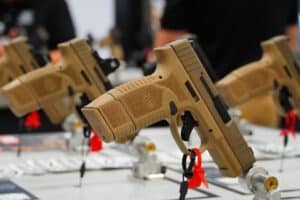Oral arguments in Cargill v. Garland concluded on Wednesday without a concrete majority emerging, but there are some clues on where each justice might stand on the ATF’s bump stock ban.
The ban, instituted at the request of former President Donald Trump in the wake of the 2017 Las Vegas shooting, has experienced an uneven ride in the lower courts. It has been upheld by some and struck down by others. Cargill’s challenge won in the Fifth Circuit back in January 2023, but only after losing at the district court level.
So, it’s perhaps unsurprising the Supreme Court hearing didn’t produce the sort of tea leaves that are easy to read.
That doesn’t mean there wasn’t any agreement. Certainly, the entire Court seemed intently interested in how exactly bump stocks work and what exactly “function of the trigger” means in the National Firearms Act (NFA) of 1934. Which makes a lot of sense since the fit–or lack thereof–between the two is likely going to determine the outcome of the case.
Does attaching a bump stock to a semi-automatic rifle convert it into something capable of “automatically” firing more than one shot with a single “function of the trigger”? The ATF said it didn’t for a long time, then they were found among the arsenal of the Las Vegas shooter after he carried out the worst mass shooting in American history, and the ATF changed its mind on the matter. The justices were much more focused on which was the correct interpretation rather than the change itself.
The liberal members of the Court seemed fairly easy to read on that question. Questions from Justices Sonya Sotomayor and Kentaji Brown Jackson seemed to imply they were pretty well convinced the language either literally covers bump stocks or that they should be covered under the intent of the statute. Justice Elena Kagan admitted “there might be some ambiguity,” but still appeared to conclude bump stocks aren’t really any different than other devices covered by the NFA.
“In all kinds of ways, you are accepting of that and saying yes, you can circumvent it by that,” she told Cargill’s counsel. “You can’t circumvent it by non-conventional triggers. You can’t circumvent it by, you know, all these things that — these hypotheticals I’ve been giving you, but you can circumvent it through this one mechanism.”
The conservatives didn’t seem as united on the core question.
Chief Justice John Roberts’ questions focused exclusively on how bump stocks work. He asked whether the shooter had to apply continuous pressure to operate a rifle with a bump stock or if the firing process required them to move their support hand back and forth. But those questions didn’t provide much insight into who he thought had the most credible explanation or what that might mean for the case.
The questions from Justice Clarence Thomas could be read as supportive of either side. He asked the government why the Court should see a difference between bump firing with or without a bump stock since the trigger is used the same way in either case. But he also asked Cargill’s lawyer why, given a bump stock helps the shooter achieve a much higher rate of fire, the device doesn’t fit into the machine gun ban.
“I think the difference is that there may be some who believe — when — when you look at it, the nature of the firing has changed as a result of the bump stock,” Thomas said. “So, if that’s changed, why don’t you simply then look backwards and say that the nature of the firing mechanism has changed; thus, the nature of the trigger has changed?”
Justice Samuel Alito took a similar track. He asked the government why the idea that a single function of the trigger is when it releases “the hammer from the sear so that the hammer can swing forward and strike” isn’t the “most straightforward interpretation” of the statute. However, he also asked the defense whether there was any conceivable reason bump stocks shouldn’t be considered effectively the same as what Congress meant to ban.
“Can you imagine a legislator thinking we should ban machineguns, but we should not ban bump stocks? Is there any reason why a legislator might reach that judgment?” he asked.
The lawyers representing each side had answers to each of these questions, of course. But there wasn’t much indication from the justices which of them they were persuaded by, and we almost certainly won’t find out until the decision is released. How the majority of those three break will determine if the ATF rule stands or falls.
That’s because Justices Neil Gorsuch and Amy Coney Barrett appeared to be the most skeptical of the government’s position in the case. Like Alito, Gorsuch argued grammar dictates that a function of the trigger is when ” the thing itself, [is] moved once.” He also criticized the less strenuous legal process the ATF used to implement its rule. Barrett focused most of her questioning on why the government saw a distinction between bump stocks and other things, such as rubber bands and belt loops, that can also be used to achieve bump firing.
And, while they both said they could understand why bump stocks should be banned, they appeared unconvinced the NFA actually restricted them.
“I can certainly understand why these items should be made illegal, but we’re dealing with a statute that was enacted in the 1930s, and through many administrations, the government took the position that these bump stocks are not machineguns,” Gorsuch said.
Although, he also asked whether the Court should be swayed by the way a semi-automatic rifle can mimic a machine gun’s rate of fire by using a bump stock. And Barrett asked if the defense could still win even if she disagreed with them that bump stocks cause a gun to function “automatically.” So, all the conservatives asked at least some questions that challenged Cargill’s lawyer.
The conservative justices also took some interest in areas beyond the specific functioning of bump stocks and the technical NFA definition of machine guns. The aforementioned ATF flip-flop on the legality of bump stocks came up a couple of times. Alito, Kavanaugh, and Gorsuch questioned the legal jeopardy the ATF’s rule had thrust potentially hundreds of thousands of Americans into. Alito implied it was “disturbing” that people could be prosecuted under the rule even though a lower court had found it unlawful. Kavanaugh criticized the idea prosecution wouldn’t require bump stock owners to be aware they had what the ATF now considers unregistered machine guns. Gorsuch mocked the government’s argument it had done enough to inform people of its changing interpretation of the devices by publishing it in the federal registrar.
It’s possible, though probably unlikely, the Court could find a majority that objects to the rule on those grounds instead of the definitional issue. But it’s much more likely whichever side gets five votes on whether bump stocks convert semi-automatic rifles into guns that automatically fire more than one round per function of the trigger will win. Most of the Court seems pretty uncomfortable that bump-stock-equipped guns can fire so fast, but it appears there may be enough of them who believe the NFA’s text doesn’t currently cover them, and it is Congress, not the ATF, who needs to expand the definition.







2 Responses
My understanding of Cargill was that it was an executive agency overreach case, not a 2A case. But the discussion that took place in the court (at least, the discussion highlighted in this article and the free news article, https://thereload.com/supreme-court-debates-legality-of-bump-stock-ban/) seemed to center around technical details of triggers and bump stocks. Are the exchanges between the justices and the attorneys highlighted in The Reload representative of the overall discussion in the court?
I don’t know why the court is discussing technical details of the underlying law without discussing the law’s constitutionality. Why does it matter what the intent of the legislature was in crafting the NFA if there is no basis in text, history or tradition for the regulation of these arms in this manner?
Does this discussion signal that the court has no stomach to faithfully apply the Bruen standard to modern laws with broad public support, such as the NFA’s regulation of machine guns?
Hey Greg. Yea, that’s correct. This case is not about the Second Amendment. In fact, Justice Kavanaugh explicitly asked Cargill’s lawyer why they decided not to include a Second Amendment claim and the lawyer responded that they didn’t think the Court would want to go beyond the scope of the case and said they weren’t sure if bump stocks fit under the dangerous and unusual exception in Heller.
So, there’s very little reason to think the Second Amendment will be at issue in the ruling.
The reason they still focused on the technical function of bump stocks is because the case mostly boils down to whether or not the ATF was right that they fit the definition of machine gun under the NFA. If they do, the ATF probably wins. If not, the Court will probably find the ATF exceeded it’s authority by effectively re-writing the law without Congressional action.